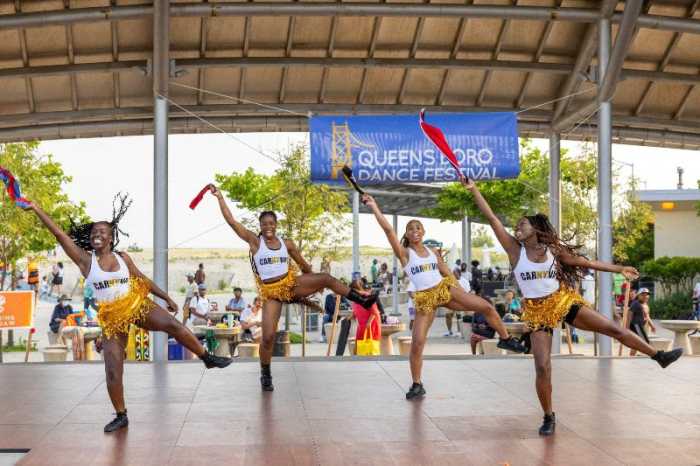By Jonathan Kaminsky
The proposed site at Vernon Boulevard and Queens Plaza South would be the first needle exchange location in Queens. Such programs, which seek to limit the spread of the HIV virus among intravenous drug users, operate in 15 neighborhoods in Manhattan, Brooklyn and the Bronx.
Jamaica and East Rockaway, areas with high HIV infection rates, are also being considered by the city's Department of Health and Mental Hygiene.
The proposed site is one block from the Queensbridge Houses and within Community District 1, which covers Astoria and Long Island City. Community District 2 covers Woodside, Sunnyside and Hunters Point.
Several Queensbridge community leaders expressed outrage over their perceived exclusion from planning stages of the program, which would be funded by and require a permit from the state Department of Health.
“This is my community,” Michael Parks, a minister at the Center of Hope International on 40th Avenue, told CB 2 members at the crowded meeting in Sunnyside. “But my opinion doesn't matter at all.”
Gioia (D-Sunnyside), in a statement read by an aide, expressed support for needle exchange programs, which also act as a link between drug users and rehabilitation programs.
But he said he was “shocked and disappointed” to learn the Queensbridge Tenants Association had not been contacted before the board meeting about the proposal. The councilman made clear his support to table the vote until more community discussion had taken place.
Philip Glotzer, executive director of the AIDS Center of Queens County, which would manage the program, said his organization and the city Department of Health and Mental Hygiene met with the CB 2 Health and Human Service Committee on Jan. 22, with CB 1 members also present, Glotzer said.
At that time, Glotzer and the Health Department proposed three sites for the needle exchange, all of which were rejected by committee members from CB 2 in favor of the current proposed site, chosen by the board members. The committee, chaired by Ron Casey, last week recommended approval of the program.
Glotzer stressed that he is flexible about the site location. The needle exchange would operate late at night once a week. He said he was anxious to meet with all concerned parties to discuss the benefits of the needle exchange program.
“Every day that we wait, another person dies a preventable death,” he said.
Joseph Conley, CB 2 chairman, worked after the meeting to schedule meetings between the Aids Center of Queens County, the Health Department and Queensbridge community groups. A meeting with the Center of Hope International was planned last weekend.
Donna Steele, the parent coordinator for PS 111 in Long Island City, said she opposed the placement of the needle exchange site in her neighborhood.
“We're tired of being the dumping ground for Queens. We don't want people coming to our neighborhood to do bad things,” she said.
Health Department Commissioner Thomas Frieden argued that most drug users do not travel to get clean needles.
“Needle programs don't attract more people to the neighborhoods in which they're located,” he said. “Drug addicts go to where the drugs are, not the needles.”
If the board approves the program, a community advisory board comprised in part of CB 2 members would monitor its progress.
In other board news, U.S. Department of Agriculture entomologist Mike Bohne presented a plan to eradicate the Asian Longhorned Beetle, a two-inch insect that bores into trees and lays eggs.
Since 1996, the beetle has spread into all five boroughs and into sections of Long Island. It has claimed more than 7,000 trees, mostly maples, throughout the city.
Astoria, Long Island City, Sunnyside and Woodside have been among of the hardest hit in Queens, but it has spread to Bayside and other northern Queens communities.
Trees infected with the bug eventually die or must be cut down and reduced to wood chips. No cure has yet been found for stricken trees and the insect has no known predators.
Federal and state workers, funded largely by Washington, are conducting a tree-by-tree survey to determine where the beetle could bore. Imidacloprid, an insecticide similar to the chemical found on flea collars, is injected into some healthy trees to help prevent the spread of the beetles.
The main challenge, Bohne said, is gaining permission to inspect trees on private property, although he quickly noted most people welcome the survey teams. The beetle is native to China and Korea, where it has devastated tree populations.
It was first discovered here in the Greenpoint section of Brooklyn in 1996. It is thought that it was transported from China in wood packing that contained replacement sewer pipes.
Bohne fears that if the beetle makes it past the city, it could destroy 30 percent of the northeastern United States' hardwood forests, with tremendous effects on the region's economy and environment.
Nevertheless, Bohne emphasized the beetle spreads slowly, is large and therefore easy to spot. With the public's cooperation, he said, “there's no reason we can't eradicate this.”


































